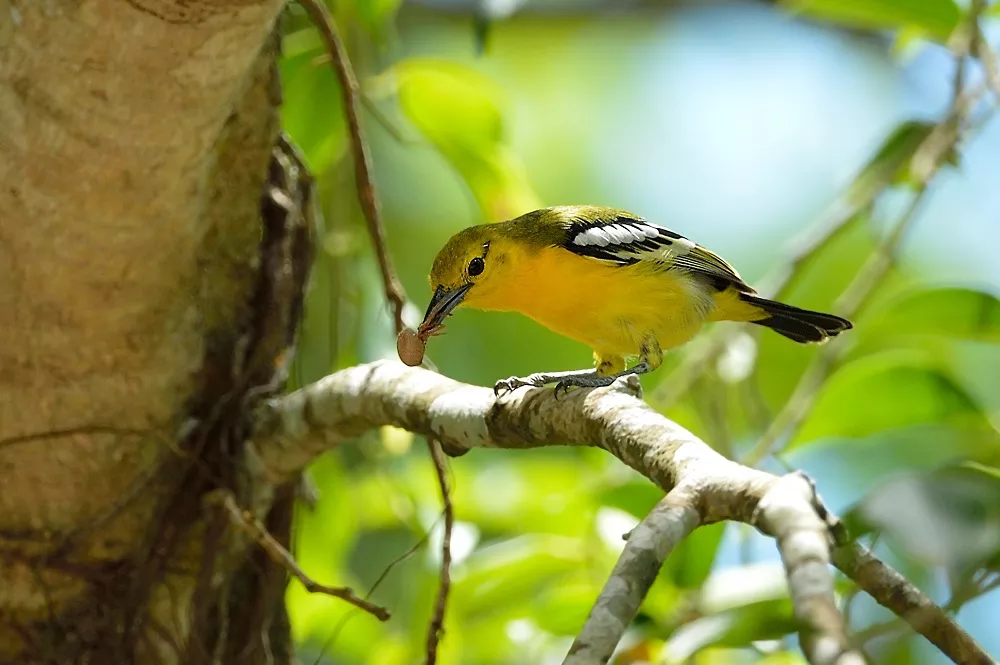The Common iora (Aegithina tiphia) is a small passerine bird found across the tropical Indian subcontinent and Southeast Asia, with populations showing plumage variations, some of which are designated as subspecies. The common iora is an arboreal green bird.
What does Common iora look like
The male bird of Common iora has a creamy forehead, olive-yellow green on the top of the head, and some occipitals are mixed with black. The back and shoulders are olive-yellow green, and sometimes the feather tips are more or less mixed with black. The two wings are black, the small coverts on the wings are black and shiny, the middle coverts and large coverts have white end spots, forming two obvious white wing spots on the wings, one of which is wide in front. The large coverts have a light yellow narrow margin. The flight feathers are black, except for the outermost 1-2 pairs of flight feathers, the tips of the other flight feathers and primary covert feathers turn white, and the innermost flight feathers also have white feather edges. Tail coverts and tail feathers bright black. The tip of the tail feathers and the outer tail feathers are decorated with olive yellow.
Creamy yellow around the eyes and around the eyes. The ear feathers, chin, throat and chest are also buttery yellow, the belly coverts to the undertail coverts are slightly lighter, olive yellow, the two flanks are yellowish green, the leg feathers are also yellowish green, the wing margins are yellow, and the underwing coverts are yellowish white.
Iris gray, off-white, silvery white, light yellow or brownish red, mouth grayish blue, silvery gray or black, tarsus gray.
Common iora size: weight 14-19 grams, body length 11.5-16cm
Common iora habitat
The common ioras mainly inhabits secondary broad-leaved forests, miscellaneous shrubs, and forest margins in low hills and plains below 1,600 meters above sea level, and also occurs in orchards, coastal mangroves, and rubber forests, and sometimes even in Near the village garden, roadside forests and bushes.
Common iora living habit
The common iora usually moves alone or in pairs, sometimes in small groups of 3-5. It is mostly active and foraging on trees or bushes, and jumps between the branches of leafy trees, which is extremely concealed.
Common iora food
Feeds mainly on insects, plant fruits and seeds.
Distribution range of common iora
Distributed in Bangladesh, Bhutan, Brunei Darussalam, Cambodia, China, India, Indonesia, Laos, Malaysia, Myanmar, Nepal, Pakistan, Philippines, Singapore, Sri Lanka, Thailand, Vietnam.
Mode of reproduction
The common iora breeds from April to July. It nests on small trees or shrubs in evergreen broad-leaved forests. The nests are mostly placed on side branches or main branches of trees, 0.6-9 meters above the ground. The nest is deep cup-shaped, mainly composed of dead grass leaves, dead grass stems, dead grass roots and moss, with thin and soft grass roots and grass blades as the inner cushion, and spider webs and spider egg shells on the outside of the nest. Each nest lays 2-4 eggs, and the eggs have two colors, one is light milky yellow or off-white, with gray markings; the other type is pink, with red markings. Eggs have a size of 16.2-19 mm x 13.2-15 mm. The male and female take turns incubating the eggs, and the chicks mature late.


 Facebook
Facebook  Instagram
Instagram  Youtube
Youtube 